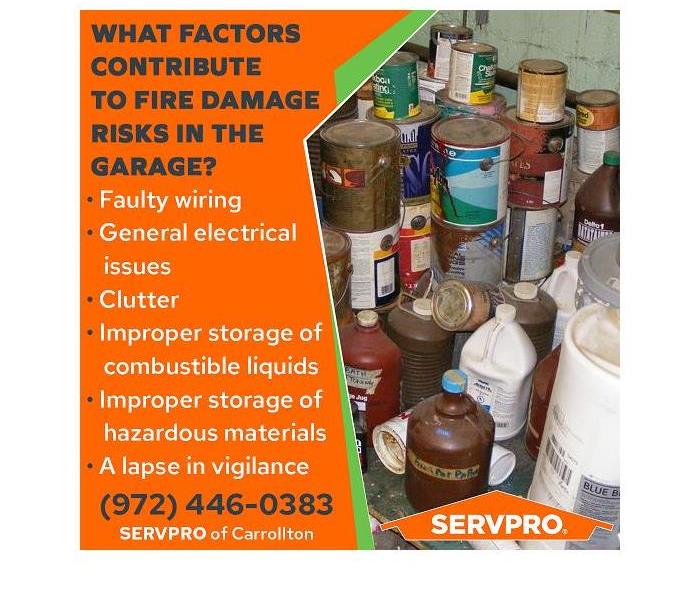What Fire Damage Risks Are Common to the Garage Area?
4/12/2022 (Permalink)
Blog Summary: SERVPRO of Carrollton warns homeowners about common fire damage risks in the garage that should not be overlooked.
Fire damage restoration in a garage that has been engulfed in flames presents a complex set of challenges for the team of professionals who have been tasked with the restoration project. Knowledge, experience, and training are essential for a fast, safe, and thorough restoration.
What Factors Contribute to Fire Damage Risks in the Garage?
The identification of potential fire hazards in the home should be top of mind for every homeowner. Some areas, such as the kitchen, are well-known for their fire risks, but other spaces, such as the garage, contain fire hazards that are often overlooked.
Fire safety in the garage sometimes receives minimal attention because the homeowner may regard the space as separate from the main structure even though the garage may be “attached.” Organization, cleanliness, and fire prevention practices are vitally important in the garage, especially if it is connected to the home. In the normal course of life, the garage is a dynamic, high-traffic living space full of activity, including work, recreational activities, and entertainment.
By giving attention to the six common garage safety hazards listed below, the homeowner can enhance the safety of the garage, as well as the rest of the home.
- Faulty wiring
At the top of the list of electrical issues that can cause a fire in the garage is faulty wiring. In fact, a leading fire prevention research and reporting group, the U.S. Fire Administration, highlighted electrical malfunctions as the number one cause of fire in the garage. Garage fires are so dangerous because the smoke and flames go unnoticed until the situation is out of control. A high concentration of flammable items, clutter, and combustible accelerants exacerbate the potential for an inferno.
An older home is more likely to experience electrical issues. The owner of an aging home is advised to consult with an electrician regarding any concerns about the garage’s electrical system. Examples of potential electrical fire hazards in an older home include the following:
- Faulty electrical outlets that spark when put into use
- Outdated outlets that lack GFCI technology
- Aging electrical wiring showing signs of deterioration such as brittle and cracking insulation
- Compromised or damaged wiring from exposure to variations in the temperature and moisture in the environment
- Damage from rodents (mice, squirrels, chipmunks, etc.) gnawing at the wiring
- Other general electrical issues
Outdated electrical circuits in the panel box can malfunction, leading to a fire. The garage often serves a dual purpose as a workstation for hobbies, home repairs, and tinkering. The improper use of extension cords can lead to catastrophic consequences. Extension cords are not a permanent solution for electrical needs in the garage. Avoid overloading an extension cord. Destroy and discard damaged cords that cannot be properly and safely repaired.
Homeowners are advised to make the switch to LED light bulbs in the garage and throughout the home. This lighting technology is energy efficient, highly luminescent, and operates at a much lower temperature than traditional incandescent lights.
- Clutter
The garage is more than a space to park the car; it also serves as a storage area. Unfortunately, the clutter can be fuel for a fire. An organizational solution can greatly reduce the fire hazard by getting the items off the floor, isolating them on a shelf, or shielding them in a cabinet or storage bin. If the item has not been used in a year, consider selling it, donating it, or disposing of it.
- Improper storage of combustible liquids
The garage is a ticking time bomb when used as a storage center for flammable liquids such as oil, gasoline, lighter fluid, aerosols, and oil-based paint. According to the American Petroleum Institute, gasoline and other flammable liquids should be stored in a safe, secure place no less than 50 feet from a structure such as a home.
- Improper storage of hazardous materials
Homeowners will often store pelletized fertilizer, oily rags, and car care products in the garage. However, this practice adds to the overall fire risk in the garage and should be avoided.
- A lapse in vigilance
Garage fires can often be traced to carelessness. Welding in the garage is not advised. Grilling in the garage is another recipe for disaster. A smoke detector, a carbon monoxide detector, and a fire extinguisher are great additions to the garage.
In the event of fire damage in the home, contact the property damage restoration professionals at SERVPRO of Carrollton, TX. The team is ready to respond 24/7, 365 days a year, including holidays.
For more information about fire damage restoration in Richardson, TX, email SERVPRO of Carrollton at office@SERVPRO10952.com. The office can also be contacted by phone at (972) 446-0383.





 24/7 Emergency Service
24/7 Emergency Service
